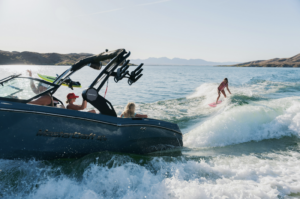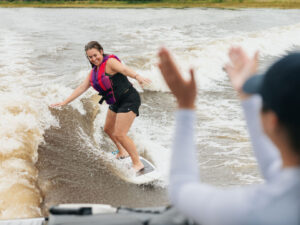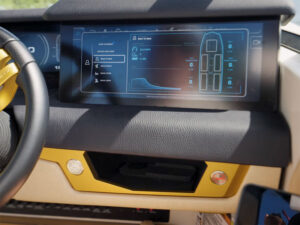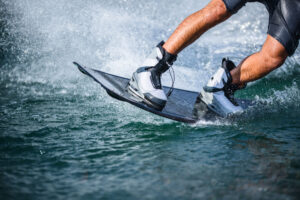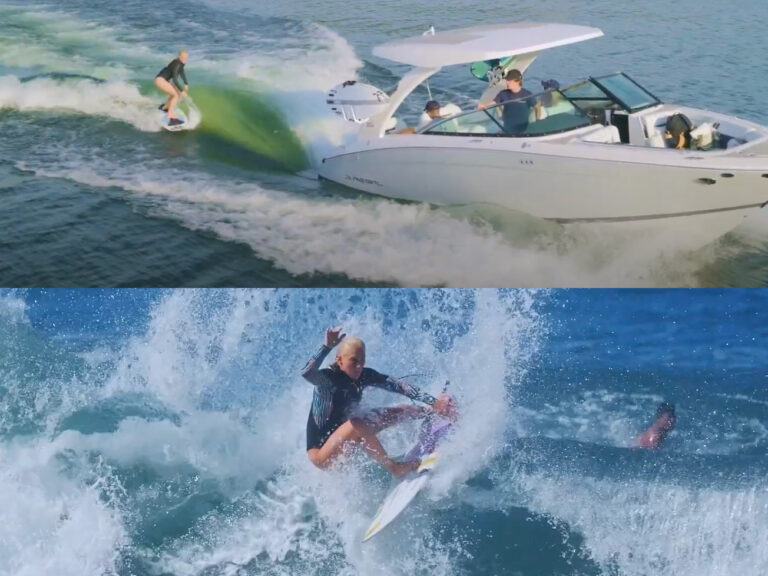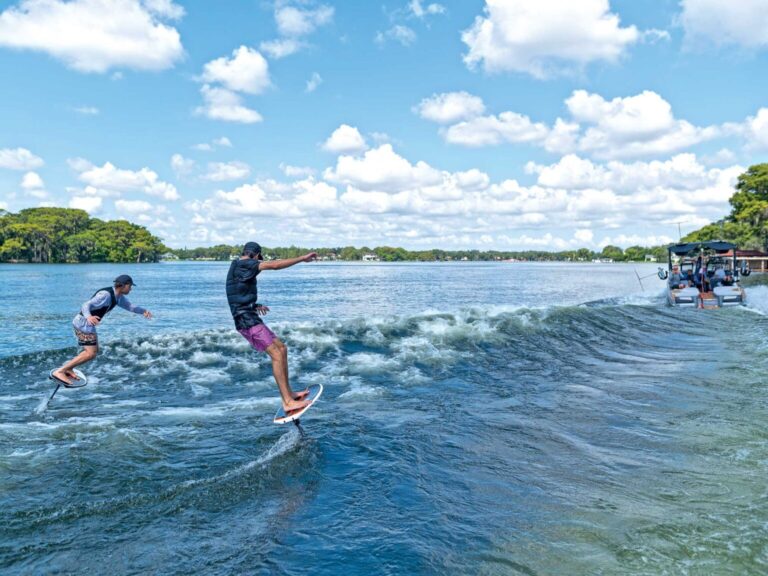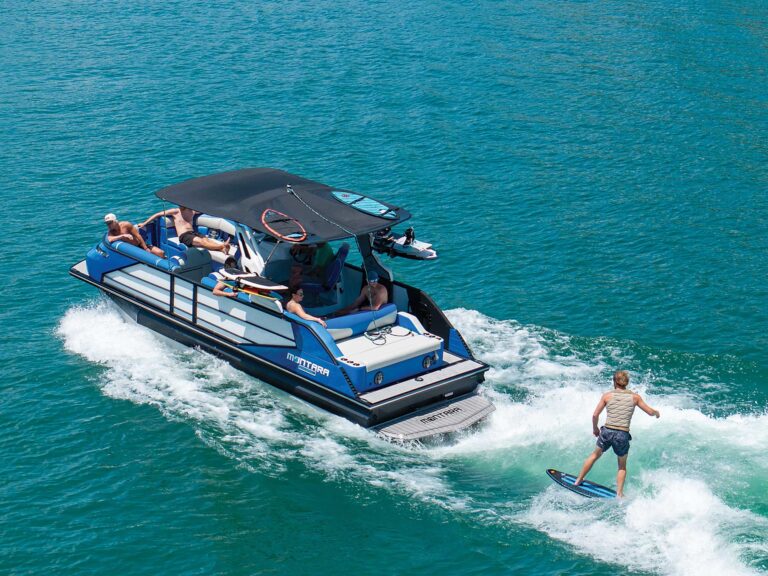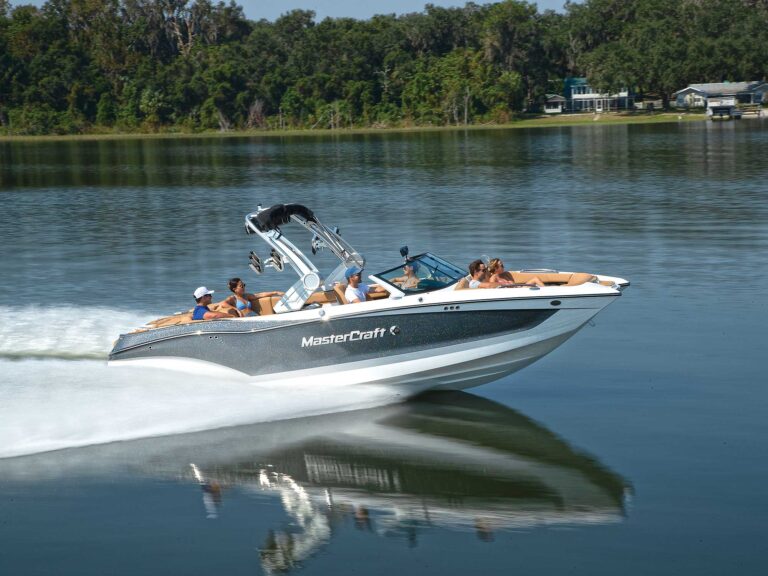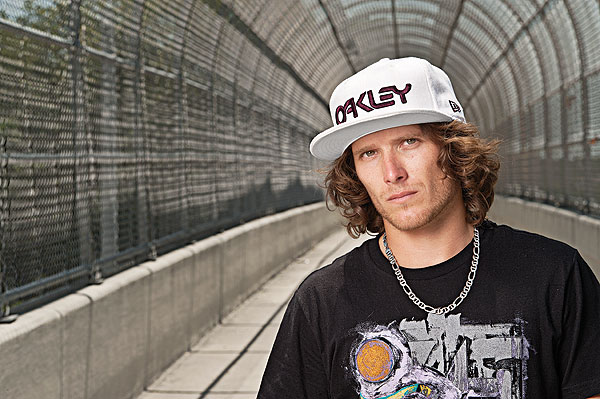
Words: Luke Woodling | Photos: Bill Doster
Olivier Derome was born and raised in Coteau-du-Lac, Quebec, a small Canadian town about 45 minutes southwest of the island of Montreal. Derome’s birthplace as a professional wakeboarder is nearly 1,500 miles south at the series of lakes, rails and trailers that comprise The Projects wakeboard and wakeskate camp outside Orlando. Derome lived and worked at the rail mecca for four years, honing a style that has made him one of the world’s elite rail riders. In fact, it was the first-ever Red Bull Wake Lab — the brainchild of The Projects mastermind Pat Panakos — that afforded Derome his first break. Matched up against the world’s best rail riders, Derome stood out for the first time, winning the revolutionary event and cementing a foundation he’s built on ever since.
While The Projects’ rail gave birth to Derome as a pro rider, the 25-year-old is far from a one-trick pony. Last year, he notched his best competitive season ever behind the boat, scoring third-place finishes at two stops of the MasterCraft Pro Wakeboard Tour. He finished seventh overall in the PWT season standings and landed just outside the top 10 in the King of Wake. In April, Derome landed his first 1080; it was only the second time a rider has completed three full rotations wake to wake.
Derome’s duality extends beyond his success on both rails and boat. Perhaps more than any other Canadian pro, Derome maintains a dual citizenship of sorts, splitting time between his birthplace and his birthplace as a pro. Derome spends much of the year as your quintessential Orlando pro, riding daily alongside Aaron Rathy and Phil and Bob Soven. Yet he still spends the summers at home in Canada, heading up a wakeboard camp called Pop Wake School with his younger brother Raphael, last year’s Rail Master at TransWorld WAKEBOARDING‘s Wake Awards.
We traced Derome’s career from early sessions as a toddler to his recent introduction into the 1080 club and found out how he maintains focus in the face of so many twin allegiances.
You got a really early start on the water, right?
My father was a national champion in water skiing. He mostly jumped. And he and my mom built a house by a lake, so they got me water skiing by 18 months old. I got into skiing as I got older, but when I got into sixth grade, all I wanted to do was wakeboard. They got me a wakeboard for my last day of sixth grade, and from then on I stopped skiing. It was a natural transition because I’ve always snowboarded and skateboarded, so being sideways was just natural.
How did you discover wakeboarding?
On the lake we lived on, there were these two teenagers with a PWC who would always wakeboard around on a Skurfer. Every time I saw them, I’d get excited. It really intrigued me, and I would ask my parents if I could build one. Eventually, they got me one. That was a really good day for me.
Where did you go from there?
I started going to this wakeboard camp, 900 Camp, that was put on by JF Gosselin and Guillaume Pare, some of the riders in the province. I went to it every year and learned my first inverts. As the years went on, they took me under their wings, and I got to do demos with them and I started helping out at the camp too. From there, I started competing, first in the province and then around the country.
Was your dad supportive of your wakeboarding?
At first he was kind of hesitant about it because it was new to him as well. He wasn’t really sure. But as he saw how much fun I was having and how happy I was wakeboarding, he let me go and do my thing. He’s very happy now that I did that.
When did you go pro?
I got my first sponsors in Quebec. A shop helped me out and then the Canadian dealers sponsored the guys at the camp and they started helping me out with boards. I wouldn’t say I was riding pro until I came to America and rode and coached at The Projects and went that route for a couple years.
When did you first come to the States, and when did you move into The Projects?
The first time I came to Florida to wakeboard was in 2002 for Worlds. I had just gone to my first Canadian Nationals and rode decently. I flew to Florida with my parents, and the day before the event I actually broke my leg. Then I’d come down usually in the spring and do a week of camp and then go back home and spend the summer there. Then I’d go back to school for the whole year and go to The Projects again in the spring. I went as a camper for two or three years. When I got close to finishing school, I e-mailed Pat and I was really lucky to get the opportunity to ride and coach at The Projects because that changed my life and my career. I started coaching and helping out and cutting the grass and doing a bunch of stuff at the camp so I could ride. I did The Projects thing for four years. I lived in a trailer for two years and then lived in the house for two years.
How much did your time at The Projects affect the way you ride?
So much. For the first two years, I lived with Ryan Doyle and Robby Jacques and Pat, and all those guys had a lot of influence on me. Keith Lidberg was always my coach, and he was always coming around and helping me out and riding with us. Doyle was always pulling rails, so he really helped me out on that, and then Robby was a great inspiration because he had such great style. Pat was almost like the father figure at the camp because he ran it and he was oldest one and he knew everything about the sport and the industry. He was just a great influence on all aspects, on and off the water. Pat was always there to help and support and guide us.
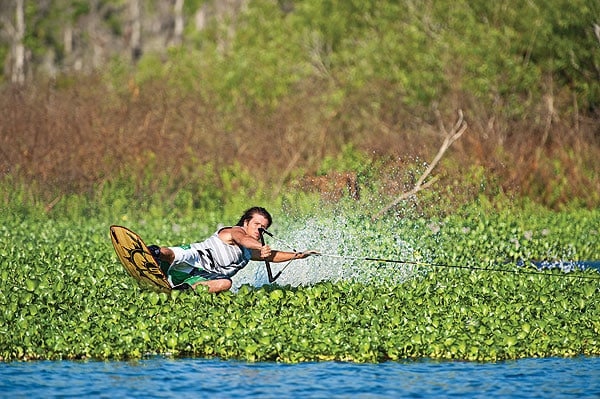
You kind of had your coming-out party when you won the first Wake Lab event back in 2008. What was that experience like?
That same year, I was doing better and better on Tour, but I never got the breakthrough I wanted. I got fourth at one of the Tour stops and fourth at Worlds, which made me realize I could actually make it behind the boat. There weren’t many rail-only events at that point, so when Wake Lab came around all the guys at The Projects, my brother and I were so stoked. We saw the setup and it was so big and impressive. It looked perfect. We actually helped build it the last week because they were a little late so they needed every hand they could get. When I actually rode the event, I was so pumped to be a part of it. I came out of it a different person.
How did that change things for you?
Until then, I never really knew if I could make it, even though that was what I was always striving for. That day I realized, “OK, this is a possibility and this is my opportunity, so I’m going to take it and make the best of it.” It was almost like I proved it to myself and I proved it to my friends and family and I proved myself to the industry all in one event. It made people realize I was going to stick around — that I wasn’t going to give up and go back to school. It laid a foundation for where I wanted to go.
Did you have that feeling standing on the podium, or was it something you realized later on down the line?
I definitely realized it later because it was overwhelming being up top with JD Webb and Aaron Rathy with a huge crowd all around. I was smiling all the way to the back of my head. I couldn’t believe it.
That was the first-ever System 2.0 event. How do you think it changed wakeboarding in the last couple years?
Eventwise, it brings it to the people. Instead of having people come out to the lake, it brought the event to the people. From the rider’s point of view, it’s amazing because there are so many possibilities. You can have different levels of pools and connect them with down rails and up rails and step-ups and step-downs. Then you have stuff like Kevin Henshaw’s C-rail, which is totally insane. It makes so many things possible to the sport that really weren’t before. It’s intense and it’s very good for progression, not only of the sport but also of up-and-comers. If you spend time riding on the System, you’re definitely going to improve everything about your riding.
How many System 2.0 events have you ridden in?
Two Wake Labs, Wake of Fame, Wake the Line in Germany and FISE in France — so five.
What was it like to ride against Raphael at Wake the Line?
I picked his name out of a bag for the first head-to-head heat of the event. I think it was the ultimate test because I knew exactly what he could do and he knew exactly what I could do.
What was it like to see him win that event?
It was amazing. If I wasn’t going to beat him, I definitely wanted him to win the whole thing. It was crazy to watch it round by round and see who he was up against and see what he would do to move on and win the whole event.
What’s the dynamic like between you guys?
We have a great relationship. Back home, we still share a room. We ride and train together. We travel together. We compete against each other. He’s six years younger than me, so he got started a little younger than I did. He always hung out with us. He never let the age thing stop him. He always kept with it and had big goals, which helped him get to where he is now.
Is there some rivalry there?
There’s definitely a rivalry, but rivalry can be good and bad. When we train together or when we’re just free-riding together, one of us will learn a trick and then the other one obviously wants to learn a trick. That’s good with your friends, but it’s even more intense when it’s your brother because you know so much about one another.
Do you guys still ride together a lot?
Yep. Last year when he came down, he was living at Rathy’s and I was living at Phil’s, which is like 15 minutes away. We tried to ride together every day. We ride together every day back home. I drive him; he drives me. It can get hectic sometimes with all the traveling and nerves at events, but most of the time it’s really good.
Do you see similarities in your riding?
I don’t think we have similar styles at all. If you shot us both backlit so you couldn’t see our faces, I think anyone could tell us apart just because he rides with such a wide stance and wide knees and he’s so low on his board when he rides the wake. We have different riding styles, but at the same time, we’ve been inspired by the same things for so long. In some ways, our riding is on a parallel path. We’re going in the same direction with our riding.
How often do you get back home these days?
I go home every summer from June through early September. I spend the whole summer there because we’re very family-oriented, and it’s the perfect spot to ride and give back to the sport that brought me a lot in the last couple years. We have a school there where we get kids out on the water and just try to give back to the sport what it’s given me. We have a Malibu and a two-tower system right there too.
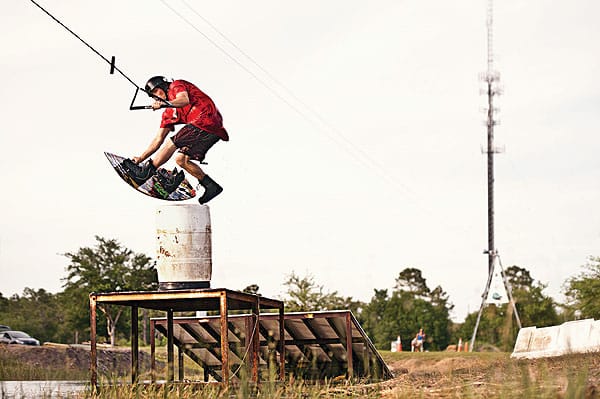
What is it like being a pro wakeboarder coming out of Canada?
I don’t think it’s easier or harder than for a kid from, I don’t know, Portland to make it. It’s just as hard to get noticed, but if you put your mind to it and put in the effort and time, I think you can make it no matter where you’re from. But it definitely helps to be down South and get those extra months and ride with the best riders.
You’re coming off your best year on Tour. Why do you think things went so well last year?
I had a stronger mind-set. Knowing what I need to do and what I can do helped out a lot. Basically, I knew my riding was good enough, but it was a matter of doing it right then and there. It has a lot to do with being mentally stronger.
Phil, Bob and Rathy are your main riding partners, right? How has that affected your contest riding and your riding in general?
Those three guys really want it bad, and they’re good riders. We all strive for the same thing and we all feed off each other and we learn from each other. I’ve learned some stuff from those guys, and sometimes those guys learn stuff from me. We all just have good chemistry.
What are your goals for this contest season?
I want to keep doing well on the King of Wake, and there are a couple of System 2.0 events in Europe I did last year that I want to go back to and do better in. I want to become a better rider — go bigger, do better tricks, make myself look better and hit new rails.
You’re respected on both the wake and rails. Is that something you focus on?
I’ve been thinking that way for a long time. It’s probably hurt me sometimes and helped me other times to concentrate sometimes more on boat than on rails or vice versa. In the end, that’s what I feel like I should be doing and where I should be.
How do you keep that balance?
It’s almost like a need. If I ride too much boat one week, I’m needy for some rails. That way, riding never gets old. There’s always something new out there that you want to do.
You just landed your first 1080, right?
Yeah, Rusty Malinoski motivated JD and I to come over and try 10s. I committed to a couple of them and felt like I could do it. I was getting closer than I thought I was going to get. On my last try, I gave it all I had. I was so surprised when I came around and saw the water. Everybody jumped around and the boat stopped. It was just a crazy moment. Twenty minutes later, what do you know, JD’s stomping one off the double-up too. It was just a crazy experience. I’m still having trouble actually believing I did it. There aren’t many things that feel better than pushing your limits and coming out of it with a positive experience.
What else are you working on?
I’ve been working on Pete 5s and crow 5s for the past couple weeks, getting those more and more consistent so I can do them in my run. Other than that, Bob and I have been messing around trying different grabs on different tricks — messing around with different axes and different corks and seeing how they turn out.
You signed with Slingshot this year. How’s that been so far?
They have a great vision for where the sport is going, and I was very excited about the opportunity because I feel like being a rider who spends so much time riding rails, flex boards are a great complement to my riding. It’s just been a great start and hopefully it will keep going and growing.
5 Keys to the Perfect Crepe
Olivier Derome shares his breakfast secrets.
1. Canadian maple syrup. It’s not the first ingredient to a great crepe, but it’s the most important. I like to make a big deal about it being Canadian because it pisses Phil Soven off.
2. It’s almost like making pancakes, but you start with a thinner batter.
3. Don’t put too much batter in the pan, and wait until it bubbles before you flip it over. Otherwise, you’re going to rip it.
4. Put whatever you want on it. I’ve had great ham and cheese crepes, and Nutella and bananas is classic.
5. If you can get your hands on it, maple butter is an amazing addition. It’s really sweet, so you just cut some slices on top, let it melt and then savor it.
